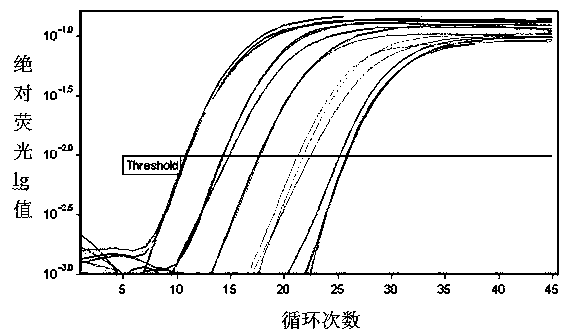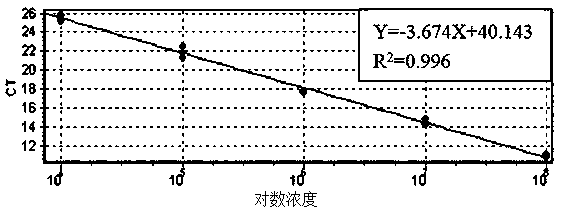Real-time fluorescent quantitative PCR nucleic acid sequences and kit for detecting Clostridium botulinum type A
A Clostridium botulinum and nucleic acid sequence technology, applied in the field of molecular detection of Clostridium botulinum, can solve the problems of time-consuming, labor-intensive sensitivity, low sensitivity, etc., and achieve the effect of sensitive response and good specificity
- Summary
- Abstract
- Description
- Claims
- Application Information
AI Technical Summary
Problems solved by technology
Method used
Image
Examples
Embodiment 1
[0034] Embodiment 1 Detects the design of special primers and probes for Clostridium botulinum type A
[0035] According to the Clostridium botulinum type A toxin gene sequence published on GenBank, use the CLUSTLAW software to perform multiple alignments of the Clostridium botulinum toxin A gene, select its stable conserved region as the detection target sequence, and design a pair of Primers and a probe, wherein the sequence of primers A-F is shown in SEQ ID No: 1; the sequence of primers A-R is shown in SEQ ID No: 2; the sequence of probes A-P is shown in SEQ ID No: 3. The 5' ends of the probes A-P are labeled with the reporter fluorophore FAM, and the 3' ends are labeled with the quencher fluorophore BHQ1. Finally, blast comparison with GenBank to determine the specificity of primers and probes, and then handed over to Shanghai Sangon Biotechnology Co., Ltd. for synthesis.
Embodiment 2
[0036] Embodiment 2 detects the composition of the kit of the fluorescent quantitative PCR of Clostridium botulinum type A
[0037] (1) qPCR reaction system components, including upstream primers A-F shown in sequence SEQ ID No: 1, downstream primers A-R shown in sequence SEQ ID No: 2 and probes A-P shown in sequence SEQ ID No: 3 , wherein the 5' end of the probe A-P is labeled with the reporter fluorescent group FAM, and the 3' end is labeled with the quencher fluorescent group BHQ1; the qPCR reaction system also includes qPCRSuperMix, the qPCR SuperMix contains dNTPs, Taq DNA polymerase and PCR reaction buffer. qPCR SuperMix was purchased from Quanshijin Biological Company.
[0038] (2) Negative control, using TE buffer, the composition is as follows: 10mM Tris-HCl, 1mM EDTA
[0039] (3) Positive control, Clostridium botulinum type A recombinant plasmid standard.
[0040] (4) Dilution buffer. Choose TransNGS from Quanshijin Biotechnology Co., Ltd. TM Library Dilution B...
Embodiment 3
[0041] Construction and preparation of embodiment 3 plasmid standard
[0042] A-F and A-R were used as primers for PCR amplification. The target product fragment was purified and recovered by gel cutting and ligated to pMD-18T vector, transformed into JM109 competent cells, screened positive clones, verified by PCR and sequenced for final confirmation.
PUM
| Property | Measurement | Unit |
|---|---|---|
| Sensitivity | aaaaa | aaaaa |
Abstract
Description
Claims
Application Information
 Login to View More
Login to View More - R&D Engineer
- R&D Manager
- IP Professional
- Industry Leading Data Capabilities
- Powerful AI technology
- Patent DNA Extraction
Browse by: Latest US Patents, China's latest patents, Technical Efficacy Thesaurus, Application Domain, Technology Topic, Popular Technical Reports.
© 2024 PatSnap. All rights reserved.Legal|Privacy policy|Modern Slavery Act Transparency Statement|Sitemap|About US| Contact US: help@patsnap.com










